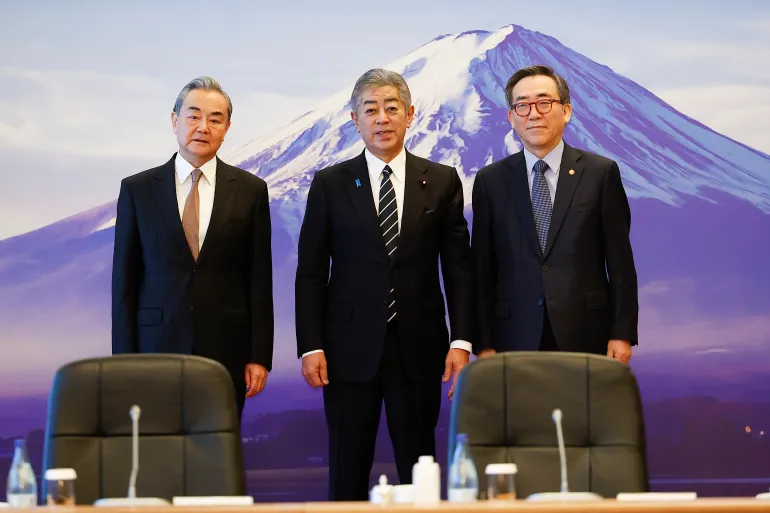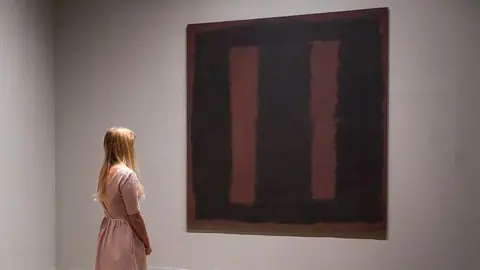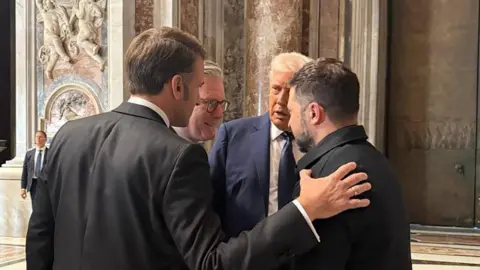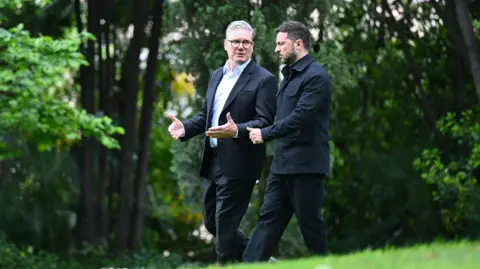Foreign News
Japan, S Korea, China meet to strengthen ties at ‘turning point in history’

The foreign ministers of Japan, South Korea and China have agreed on the need to seek common ground on East Asian security and economic issues amid escalating global uncertainty.
Japanese Foreign Minister Takeshi Iwaya, his Chinese counterpart Wang Yi and South Korea’s Cho Tae-yul have agreed to tackle multigenerational concerns to gain broader support for cooperation, Iwaya said in a joint news conference in Tokyo on Saturday.
The first gathering of the countries’ foreign ministers since 2023 comes as United States President Donald Trump upends decades-old alliances, potentially opening the door for China to forge closer ties to countries traditionally aligned with Washington.
“The international situation has become increasingly severe, and it is no exaggeration to say that we are at a turning point in history,” Iwaya said at the start of the meeting.
“In this context, it has become more important than ever to make efforts to overcome division and confrontation through dialogue and cooperation,” he said.
The three-way meeting is an accomplishment for Japan, which has historical and territorial disputes with both China and South Korea. An earlier trilateral meeting was held in South Korea last year.
China’s Wang said that as this year marks the 80th anniversary of the end of World War II, “only by sincerely reflecting on history can we better build the future”.
He said China supports strengthening cooperation, allowing the countries “to jointly resist risks” and promoting “mutual understanding” between their populations.
“Our three nations have a combined population of nearly 1.6 billion and an economic output exceeding $24 trillion. With our vast markets and great potential, we can exert significant influence,” Wang said.
China, he added, wants to resume free trade talks with its neighbours and expand membership of the 15-nation Regional Comprehensive Economic Partnership.

Reporting from Tokyo, Al Jazeera’s Fadi Salameh said the meetings aim to “build confidence between these three countries”.
“But still, there are so many differences and issues that divide the three countries,” Salameh said.
“Mr Wang Yi, the Chinese foreign minister, mentioned that the three countries – maybe targeting Japan with this point – should be honest about the historical issues that divided [them],” Salameh explained, referring to Yi’s mention of World War II and Japan’s war of aggression.
Beijing is at odds with Tokyo and Seoul on several other key issues, including its support of North Korea, its intensifying military activity around Taiwan, and its backing of Russia in its war with Ukraine.
US allies Japan and South Korea, which each host thousands of US soldiers, share Washington’s view that China – the world’s second-largest economy – poses a growing threat to regional security.
Cho said he had asked China in the meeting to help persuade North Korea to abandon its nuclear weapons.
“I also stressed that illegal military cooperation between Russia and North Korea should stop immediately, and that North Korea should not be rewarded for its wrongdoings in the course of bringing about the end of the war in Ukraine,” he added.
Iwaya is to meet separately with his Chinese and South Korean counterparts, including for the first high-level economic dialogue with Beijing in six years.
That meeting will include a discussion of a ban on Japanese seafood imports imposed by China after the release of wastewater from the destroyed Fukushima nuclear plant from 2023, Iwaya said this week.
[Aljazeera]
Foreign News
Child damages €50m Rothko painting in Dutch museum

A child has damaged a painting worth millions of pounds by the American artist Mark Rothko at a museum in Rotterdam.
A spokesperson for the Museum Boijmans Van Beuningen said it was considering the “next steps” for the treatment of Rothko’s Grey, Orange on Maroon, No. 8.
The damage occurred during an “unguarded moment”, a museum spokesperson told the Dutch media outlet Algemeen Dagblad (AD) last week.
A spokesperson for the museum told the BBC the damage was “superficial”, adding: “Small scratches are visible in the unvarnished paint layer in the lower part of the painting”.
The abstract painting is estimated to be worth up to €50m (£42.5m), according to newspaper AD.
“Conservation expertise has been sought in the Netherlands and abroad. We are currently researching the next steps for the treatment of the painting”, the museum spokesperson told the BBC.
“We expect that the work will be able to be shown again in the future,” they added.
Sophie McAloone, the conservation manager at the Fine Art Restoration Company, said that “modern unvarnished” paintings like Rothko’s Grey, Orange on Maroon, No. 8 are “particularly susceptible to damage”.
This is “owing to a combination of their complex modern materials, lack of a traditional coating layer, and intensity of flat colour fields, which make even the smallest areas of damage instantly perceptible,” she said.
“In this case, scratching of the upper paint layers can have a significant impact on the viewing experience of the piece,” Ms McAloone said.
The Rothko painting was hanging in the museum’s Depot – a publicly accessible storage facility beside the main museum – as part of an exhibition displaying a selection of “public favourites” from the gallery’s collection.
Jonny Helm, a marketing manager at the art restoration service Plowden & Smith, said the incident had implications for UK institutions such as V&A East and the British Museum, which are considering “opening up the display of things that would otherwise be obscured in archives.”
“How will this event affect other UK institutions who are opening up their archives in the same way?” Mr Helm said.
Restoring a Rothko painting is a difficult task because “Rothko’s mixture of pigments and resins and glues were quite complex”, Mr Helm said.
He said the fact the painting is unvarnished – meaning it is “open to the environment” – will pose an additional challenge to conservators.
Conservators working to restore the painting will now likely be in the process of documenting the extent of the damage and researching “historic successful treatments” of Rothko paintings.
“Rothko works seem to have terrible luck – this isn’t the first damaged Rothko we’ve heard about,” Mr Helm said.
Rothko’s 1958 work, Black on Maroon, was deliberately vandalised by Wlodzimier Umanjec at London’s Tate Modern gallery in October 2012. Umaniec was sent to prison for two years and subsequently apologised for his actions.
During his trial, prosecuting barrister Gregor McKinley said the cost of repairing the work would be about £200,000. It took conservators 18 months to repair the painting.

Rachel Myrtle, Head of Specie and Fine Arts at Aon, a company that offers insurance broking to its clients, said fine art insurance policies typically cover “all risks associated with physical loss and damage to artwork”.
This includes “accidental damage caused by children or visitors, albeit with certain exclusions”, she said.
She said that when an artwork is damaged, a gallery’s insurer will appoint a specialist fine art loss adjuster to visit the museum.
The loss adjustor typically “reviews the damage to the artwork, examines any CCTV footage to determine the exact cause of the loss, and assesses conservation options”, Ms Myrtle said.
The museum did not comment on who will be held liable for the damage to the 1960 painting, which the gallery reportedly bought in the 1970s.
The Museum Boijmans Van Beuningen has previously billed visitors who have caused damage to artworks on display.
In 2011, the museum asked an unsuspecting tourist who stepped on Wim T. Schippers’ peanut butter floor artwork, called Pindakaasvloer, to pay for repairs to the work. Sharon Cohen, a spokesperson for the museum at the time, wax quoted by AD as saying “It is normal procedure for people to pay if they damage art.”
The Rothko painting is described by the museum as an example of colour field painting, a term used to describe art characterised by large blocks of flat, solid colour spread across a canvas.
Rothko’s Grey, Orange on Maroon, No. 8 painting is one of several works of modern art that have been damaged in the Netherlands in recent years.
In November 2024, multiple screen prints by the US pop artist Andy Warhol were damaged by thieves during an attempted robbery of the MPV art gallery in the town of Oisterwijk.
In another incident, a Dutch town hall admitted it most likely disposed of 46 artworks by accident – including an Andy Warhol print of the former Dutch queen – during renovation works last year.
Museums have different policies when responding to damage caused by children.
In August last year, a four year old boy accidentally smashed a 3,500 year old jar into pieces at the Hecht Museum in Israel. At the time, Hecht Museum worker Lihi Laszlo told the BBC the museum would not treat the incident “with severity” because “the jar was accidentally damaged by a young child”.
The family were invited back to the exhibition for an organised tour shortly after the incident occurred.
[BBC]
Foreign News
‘Mass casualty incident’ as car driven into Vancouver street festival

Police are investigating a “mass casualty incident” in which “several people were killed” after a car was driven into a crowd in Vancouver.
Authorities in the Canadian city said “multiple others” were injured during the incident, which occurred at approximately 20:14 local time on Saturday (03:14 GMT on Sunday) at a street festival.
Police said a 30-year-old male suspect was in custody and that they were “confident that this incident was not an act of terrorism”. It is unclear how many people have been killed.
Police said the suspect had driven into pedestrians at the annual Lapu Lapu festival, which celebrates Filipino culture, at East 43rd Avenue and Fraser, in the south of Vancouver.
Steve Rai, Vancouver Police’s interim chief, told a news conference that there had been one vehicle and one suspect involved in the incident. He said more details would be released in the morning.
The owner of a food truck selling bao buns at the festival, Yoseb Vardeh, told the BBC World Service that the attack happened right in front of his van.
“This guy, he killed some of my customers,” he said. “There was people waiting for their buns that got hit.”
Mr Vardeh added: “I stepped outside of my food truck and I just saw bodies underneath people’s food trucks, husbands crying out for their wives or their kids… It was just horrible.”
Unverified footage posted on social media showed a number of police cars, ambulances and fire engines at the scene, with injured people lying on the ground.
Canadian Prime Minister Mark Carney said in a statement on X that he was “devastated to hear about the horrific events at the Lapu Lapu festival in Vancouver”.
He continued: “I offer my deepest condolences to the loved ones of those killed and injured, to the Filipino Canadian community, and to everyone in Vancouver. We are all mourning with you.”
He also thanked emergency responders for their “swift action”.
Vancouver Mayor Ken Sim said he was “shocked and deeply saddened by the horrific incident”, adding in a post that his “thoughts are with all those affected and with Vancouver’s Filipino community during this incredibly difficult time.”
One of Vancouver’s city councillors, Peter Fry, told the BBC that local residents were struggling to process what had happened.
“This celebration was a huge, fun, vibrant, family-orientated street party, and it was a fantastic event. To see it turn so horrible so quickly and unexpectedly has, I think, our entire city is in shock,” he said.
Lapu Lapu Day is celebrated every year in the Philippines on 27 April to commemorate Lapu-Lapu, a national hero who resisted Spanish colonisation.
The festival was officially set up in Vancouver in 2023. Its website says it “symbolises the cultural harmony and mutual respect that thrive in the province of British Columbia”.
In the wake of the attack, leaders of different political parties have also been sharing messages of condolence.
Pierre Poilievre, leader of Canada’s Conservative Party, called the incident a “senseless attack”, while the leader of the British Columbia New Democratic Party, David Eby, said he was “shocked and heartbroken”.
New Democratic Party leader Jagmeet Singh – who had attended the festival but was not present when the incident occurred – said he was “horrified to learn” that innocent people had been killed and injured.
“As we wait to learn more, our thoughts are with the victims and their families – and Vancouver’s Filipino community, who were coming together today to celebrate resilience,” he added.
Singh, Poilievre and Carney are all running in Canada’s federal election on Monday. Singh’s constituency of Burnaby Central lies just east of where the incident took place.
[BBC]
Foreign News
Trump questions Putin’s desire for peace after meeting Zelensky at the Vatican

Donald Trump has questioned Vladimir Putin’s willingness to end the war in Ukraine following his meeting with the country’s leader Volodymyr Zelensky on the sidelines of Pope Francis’s funeral.
Posting on social media after leaving Rome, Trump said he feared Putin was “tapping me along” after Moscow’s strikes on Kyiv earlier this week, adding there was “no reason for Putin to be shooting missiles into civilian areas”.
Earlier in the day Trump and Zelensky were seen in deep discussion in St Peter’s Basilica shortly before the funeral began.
The White House described the 15-minute meeting with Zelensky as “very productive”. The Ukrainian president said it had the “potential to become historic”.
It was Trump’s first face-to-face encounter with the Ukrainian president since February’s acrimonious Oval Office showdown.
Writing on his Truth Social account, Trump said the Russian attacks on Ukrainian cities “makes me think that maybe he doesn’t want to stop the war, he’s just tapping me along, and has to be dealt with differently, through ‘Banking’ or ‘Secondary Sanctions?'”.
Trump had previously said Russia and Ukraine were “very close to a deal” following three-hour talks between his envoy Steve Witkoff and the Russian president on Friday.
The Kremlin meanwhile said on Saturday that Putin had confirmed Russia’s readiness to enter into direct talks with Ukraine “without preconditions” to Witkoff.
During their last face-to-face meeting at the White House, Trump had told Zelensky “you don’t have the cards” and that he was not winning against Russia.
Trump repeated that message this week, saying the Ukrainian leader had “no cards to play”. He has previously blamed Ukraine for starting the war and has accused Zelensky multiple times of being an obstacle to peace negotiations.
But the White House struck a more positive tone about Saturday’s meeting, while Zelensky described the sit down as a “very symbolic” and one which could prove significant “if we achieve joint results”.
Two images were released of the meeting, showing the US leader in a blue suit and Ukrainian president in a black top and trousers, locked in intense conversation while sitting opposite each other.
Ukraine’s Foreign Minister Andrii Sybiha also posted an image of the meeting on X with the caption: “No words are needed to describe the importance of this historic meeting. Two leaders working for peace in St. Peter’s Basilica.”

Another image posted by the Ukrainian delegation from inside St Peter’s showed the two men standing alongside UK Prime Minister Sir Keir Starmer and French President Emmanuel Macron, whose hand is on Zelensky’s shoulder.
The implication was that the two European leaders – who have regularly acted as intermediaries for Trump and Zelensky – had helped to bring the two together against the sombre backdrop of the funeral.
After the meeting, Trump and Zelensky walked down the steps of the basilica, where Zelensky’s arrival was met with applause from the crowds, and took their seats in the front row.
During the service, the pair sat a short distance from each other, with Macron and other heads of state in between.
In his homily, Cardinal Giovanni Battista Re spoke of Pope Francis’s incessant calls for peace. “‘Build bridges, not walls’ was an exhortation he repeated many times,” said the cardinal.
Ukrainian officials had talked of a possible second meeting, but Trump’s motorcade drove away from St Peter’s immediately afterwards and his plane left Rome a short time later.
Zelensky, however, later met Macron in the garden of Villa Bonaparte, home to the French embassy to the Holy See.
He also met Sir Keir at Villa Wolkonsky, the British ambassador’s residence, as well as holding separate talks with EU Commission President Ursula von der Leyen.

Macron said ending the war in Ukraine was an objective that “we share in common with President Trump” in a post on X, adding that Ukraine was ready for “an unconditional ceasefire”.
A Downing Street spokesperson said Starmer and Zelensky discussed the positive progress that had been made recently to “secure a just and lasting peace in Ukraine,” adding that the pair had agreed to “maintain momentum” and “speak again at the earliest opportunity”.
During February’s heated White House exchange, Trump accused the Ukraininan president of gambling with World War Three by not going along with ceasefire plans led by Washington.
Kyiv has been on the receiving end of growing pressure from Trump to accept territorial concessions as part of an agreement with Moscow to end the war.
These concessions would reportedly include giving up large portions of land, including the Crimean peninsula which was illegally annexed by Russia in 2014.
Zelensky has repeatedly rejected the idea in the past. He suggested to the BBC on Friday that “a full and unconditional ceasefire opens up the possibility to discuss everything”.
[BBC]
-

 Business3 days ago
Business3 days agoPick My Pet wins Best Pet Boarding and Grooming Facilitator award
-

 News7 days ago
News7 days agoProf. Rambukwella passes away
-

 News3 days ago
News3 days agoNew Lankan HC to Australia assumes duties
-

 Features3 days ago
Features3 days agoKing Donald and the executive presidency
-

 Business3 days ago
Business3 days agoACHE Honoured as best institute for American-standard education
-

 Features7 days ago
Features7 days agoThe sea-change after Modi’s visit
-

 Features5 days ago
Features5 days agoThe Truth will set us free – I
-

 Midweek Review7 days ago
Midweek Review7 days agoB’caloa Tigers’ 2004 shock revolt in retrospect












